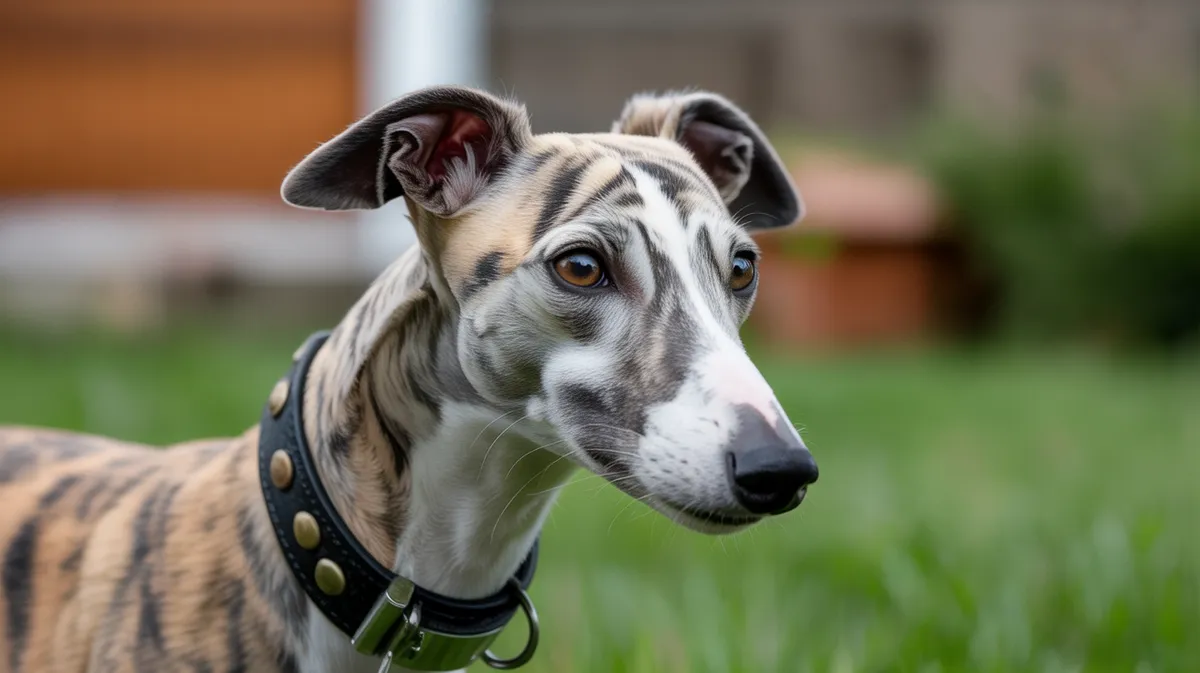
Whippet
Canis lupus familiaris

Meet the Whippet
The Whippet is a slender, medium-sized breed of domestic dog known for its remarkable speed and graceful build. Originally bred in England for racing and hunting small game, Whippets are admired for their gentle temperament and affectionate nature. Their short, smooth coats come in a variety of colors and patterns, and their streamlined bodies make them agile and fast, capable of reaching speeds up to 35 mph (56 km/h). Whippets are friendly, intelligent, and enjoy both active play and quiet relaxation, making them excellent companions for families and individuals alike.
Classification
Mammal
Habitat
Domestic environments, urban and suburban homes
Diet
Carnivore
Lifespan
12-15 years
Conservation
Least Concern
Weight
11-18 kg (24-40 lbs)
📖Fascinating Facts
Super Sprinter
Whippets can reach speeds up to 35 mph (56 km/h), making them one of the fastest dog breeds worldwide.
Calm Companions
Despite their athleticism, Whippets are known for their quiet and calm demeanor indoors, often enjoying long naps on comfortable furniture.
Colorful Coats
Whippets come in nearly every color and pattern, including solid, brindle, and parti-colored variations.
📋Detailed Description
The Whippet is a medium-sized sighthound, typically weighing between 9–19 kg (20–42 lbs) and standing 44–51 cm (17–20 in) at the shoulder, with males generally larger than females. Its anatomy is characterized by a deep chest, long, arched neck, and a slim, muscular build, designed for explosive acceleration and sustained speed. The breed's fine, short coat comes in nearly every color and pattern except merle, and requires minimal grooming. Whippets possess a long, tapered tail and a narrow, aerodynamic skull with a long muzzle, enhancing their ability to spot and pursue prey visually. Their large, expressive eyes provide a wide field of vision, a trait common to sighthounds. Behaviorally, Whippets are gentle, affectionate, and highly adaptable, thriving in both active and calm environments. They are known for their 'double suspension gallop,' a running style that allows them to reach speeds up to 56 km/h (35 mph), making them the fastest dog for their size. Socially, Whippets are generally friendly with people and other dogs, but retain a strong prey drive toward small animals. Reproduction is typical of domestic dogs, with litters averaging 4–8 puppies. Unique among sighthounds, Whippets are noted for their quiet demeanor indoors, often seeking warmth and comfort, and are sometimes referred to as 'couch potatoes' when not exercising.
💡 Did you know?
Unlike most dogs, Whippets have very little body fat and are sensitive to cold, often requiring coats or sweaters in chilly weather.
🔬Research & Sources
Wikipedia Summary
The Whippet is a British breed of dog of sighthound type. It closely resembles the Greyhound and the smaller Italian Greyhound, and is intermediate between them in size. In the nineteenth century it was sometimes called "the poor man's racehorse". It is commonly kept as a companion dog, for competitive showing or for amateur racing, and may participate in various dog sports, including lure coursing, agility, and flyball. It has the fastest running speed within its weight and size range, and is believed to have the fastest idle-to-running acceleration of any dog.
Last Modified: 3/13/2025
🎭Behavior & Social Structure
Whippets display a dichotomous behavior pattern: they are energetic and playful outdoors, especially when given the opportunity to sprint or chase, but are calm and restful indoors. Their hunting behavior is rooted in visual pursuit; they are highly responsive to moving objects and may instinctively chase small animals. Feeding behavior is typical of domestic dogs, though some individuals may be selective eaters. Socially, Whippets are pack-oriented, enjoying the company of both humans and other dogs, and rarely show aggression. They communicate through body language and a range of vocalizations, though they are not known to be excessive barkers. Daily routines often include short bursts of intense activity followed by long periods of rest. They are sensitive to harsh discipline and respond best to positive reinforcement training.
👶Reproduction & Life Cycle
Whippets reach sexual maturity between 6–12 months, though responsible breeding is typically delayed until at least 18 months of age. The breed exhibits no marked seasonality in estrus cycles, and mating behavior is similar to other domestic dogs, involving courtship and copulation. Gestation lasts approximately 63 days, with litters averaging 4–8 puppies. Whippet mothers are attentive, providing warmth, grooming, and nourishment to their young. Puppies are born blind and deaf, opening their eyes at around 10–14 days. Weaning begins at 3–4 weeks, and puppies are usually ready for adoption by 8–12 weeks. Breeders often select for temperament, health, and conformation to breed standards.
🛡️Adaptations & Survival
Whippets are highly specialized for speed and agility. Their flexible spine, deep chest, and long limbs enable the double suspension gallop, maximizing stride length and efficiency. The breed's low body fat and thin skin reduce weight and heat retention, but also make them sensitive to cold. Their keen eyesight and rapid acceleration are evolutionary adaptations for coursing small game, such as rabbits. Behaviorally, Whippets have adapted to domestic life by developing a calm, unobtrusive temperament, making them suitable for indoor living. Their strong prey drive and visual acuity are retained from their hunting ancestry.
📚Research Sources
🎨Cultural Significance
Historically, Whippets were known as the 'poor man's racehorse' in 19th-century England, where they were used for snap dog racing and rabbit coursing by working-class communities. The breed has since become a popular companion animal and show dog, admired for its elegance and athleticism. Whippets are featured in art and literature as symbols of speed, grace, and gentleness. They have influenced the development of other sighthound breeds and are celebrated in dog sports such as lure coursing, agility, and flyball. Their quiet, affectionate nature has made them a favorite among urban and suburban pet owners.
🔬Recent Research & Discoveries
Recent genetic studies have clarified the Whippet's ancestry, confirming close relationships with Greyhounds and Italian Greyhounds. Research into the 'speed gene' (myostatin mutation) has identified variants in some Whippets that enhance muscle development and sprinting ability, though double mutations can lead to 'bully whippet syndrome.' Ongoing studies focus on breed-specific health issues, including cardiac and ocular diseases, and the impact of selective breeding on genetic diversity. Behavioral research highlights the breed's adaptability and low aggression, supporting its suitability as a family companion. Advances in canine sports medicine have improved injury prevention and rehabilitation for athletic Whippets.
🎥Wildlife Videos

A day in the life of a whippet
Loving the beach! To accompany the kindle book "for the love of whippets". As well as wildlife I love to film my whippets running ...
Alex Sally

Whippets and Rapid Rabbits - Ferreting in Australia 3 🇦🇺
Out in Australia with the whippets and ferrets. First hole the ferret had a rabbit pinned down within arms reach so Dale ...
Zeus Polecat

ALL ABOUT WHIPPETS: SWEET AND SLEEK SIGHTHOUND
Please support the Channel by checking out my affiliate links!!! Become a Dogumentary TV Channel member!!!
Dogumentary TV

Ferreting with Aussie Whippet Trio - Ferreting in Australia 1 🇦🇺
Whippets PJ, Lilly and their son Champ work with the ferrets to catch rabbits under a shed on an Australian farm. The ferrets chase ...
Zeus Polecat

Ep. 3 - Kelly & Nala + Wilfred, exploring the human/animal connection (documentary)
Kelly discusses the ways that her Whippets, Nala and Wilfred, have supported her through loss, motherhood, and the stresses of ...
Alice Lattimore
🌍Habitat Information
The Whippet typically inhabits Domestic environments, urban and suburban homes environments. Whippets have adapted to their environments with specialized features and behaviors.
Primary Habitat:
Domestic environments, urban and suburban homes
More detailed habitat information will be available soon.
🛡️Conservation Status
The Whippet is currently classified as Least Concern. Conservation efforts are crucial for preserving this species for future generations.
Common Threats:
- 🏠Habitat loss and fragmentation
- 🌡️Climate change impacts
- 🎯Hunting and poaching
- 🏭Human-wildlife conflict
⚠️Threats & Conservation Challenges
As a domestic breed, Whippets face few natural threats, but are vulnerable to certain genetic health issues, such as cardiac arrhythmias, eye disorders (e.g., progressive retinal atrophy), and anesthesia sensitivity due to low body fat. Accidental injuries from high-speed running, such as fractures or soft tissue damage, are also a concern. Overbreeding and irresponsible breeding practices can contribute to inherited diseases. The breed is not threatened in terms of population, but responsible breeding and health screening are important for long-term welfare. Whippets are sensitive to extreme cold and require protection in harsh climates.
🔬Scientific Classification
Scientific Name
Canis lupus familiaris
Classification Hierarchy
🔍 About Taxonomic Classification
Taxonomic classification is a hierarchical system used by scientists to classify and organize living organisms based on shared characteristics and evolutionary relationships.
The system moves from broad categories (Kingdom) to increasingly specific ones, with each animal's scientific name typically consisting of its Genus and species.
📝Community Notes
Share your observations and insights about the Whippet with our community of wildlife enthusiasts.
Join Our Community
Sign in to share your observations and connect with fellow wildlife enthusiasts.
Sign In to ContributeNo community notes yet
Be the first to share your observations about the Whippet!
Explore Whippet
Select a tab above to learn more about this amazing animal.
📸Photo Gallery
No photos available for this animal yet.
🌟Discover More Wildlife
Continue your journey of discovery with more fascinating animals from our database
